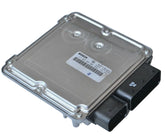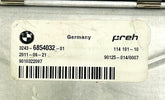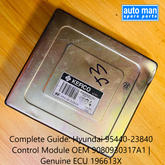TCUs are the brains behind modern automatics and CVTs. They manage when gears shift and how the transmission behaves. In this guide, you’ll learn what a transmission control unit does, common failure causes and practical paths for repair or replacement.
Key Takeaways
-
Electrical issues drive most failures in TCUs, not the module itself, often from wiring or voltage problems.
-
Replacement costs vary but typically span $300–$800+ for parts and labor in the U.S.
-
Water damage and overheating are common culprits and quick action saves downtime.
-
Look for OEM used or renewed TCUs with warranties and fast U.S. shipping.
-
Automan Spare Parts offers OEM used TCUs with 30‑day warranties and handy promotions.
What is a Transmission Control Unit (TCU/TCM)?
The transmission control unit is the module that guides automatic or CVT shifts by reading sensors and commanding the transmission actuators.
Definition: A TCU/TCM processes engine data, road/drive conditions, and driver input to set shift points, lock the torque converter, and control hydraulic circuits.
What it does: It coordinates gear changes, shift timing, and hydraulic control based on data from speed, temperature, and pedal inputs.
Why it fails: Electrical faults, water exposure, heat, corrosion, and software glitches all contribute to failures.
Common problems and failure causes
TCUs fail for electrical, environmental, or mechanical reasons. Knowing the causes helps you diagnose and fix faster.
Electrical issues and wiring problems
Loose connectors, damaged wires, blown fuses, and voltage hiccups disrupt sensor-actuator signals.
Impact: Miscommunication can cause rough shifting or limp mode.
Water damage and corrosion
Leaks or floods accelerate corrosion and short circuits in the module.
Impact: Erratic shifting or failure to engage gears.
Overheating and cooling‑related failures
Excess engine heat or poor cooling stresses the TCU and sensors.
Impact: Delayed engagement or intermittent shifts.
Sensor and connector faults
Bad speed or temperature sensors and bad harness connections mislead the TCU.
Impact: Incorrect shift points.
Software/firmware glitches
Outdated or corrupted software can alter control logic.
Impact: Shifting anomalies or warning lights.
External factors
Contaminated fluid or debris in the valve body can stress electronics.
Impact: Transmission misbehavior.
Symptoms that indicate a failing TCU
Look for shifts that don’t follow normal patterns and warning lights.
-
Transmission won’t shift properly or stalls in a gear.
-
Delayed, harsh, or erratic shifting.
-
Limp mode or inability to move beyond neutral.
-
Check Engine or transmission codes, like P0700 on some makes.
-
Inconsistent behavior across driving conditions.
Diagnosis: How to determine if the TCU is failing
A structured diagnostic flow helps confirm the root cause.
-
Retrieve fault codes with a compatible scan tool.
-
Inspect wiring harnesses, connectors, and grounds for corrosion or damage.
-
Check transmission fluid level and condition for contamination.
-
Test the battery and charging system for voltage stability.
-
Test relevant sensors and circuits (speed, temperature).
-
Review live data to observe sensor readings and TCU outputs.
-
If basics don’t reveal the cause, consider professional diagnostics.
In‑vehicle vs bench testing: In‑vehicle tests show behavior under load; bench tests validate the unit out of the car.
Root-cause awareness: If wiring or sensors drive the issue, the TCU may not be the culprit.
Repair vs replacement: Pros, cons, and decision guide
Decide based on the fault type and downtime you can tolerate.
-
Repair: Lower upfront cost preserves OEM calibration in some cases, faster downtime. But not all failures are fixable.
-
Replacement: Clear warranty, known working state, faster return to service. But higher upfront cost and more checks for compatibility.
When to choose: Electrical wiring or simple sensor faults may be repairable. If the module is internally damaged, replacement (new or OEM used with warranty) is usually best.
Costs and time estimates (U.S. market, 2025 context)
Budget for parts and labor when planning a TCU fix.
Typical costs range from $300–$800+ including parts and labor. Diagnostic fees vary from $0–$150. Labor time is usually 2–6 hours depending on the car.
From a sourcing perspective, OEM used TCUs with a 30‑day warranty are common. Expect US delivery in a few days with occasional promotions for free or discounted shipping.
How to choose a TCU/TCM and where to buy
Pick an exact part number match and a reputable seller with clear returns.
Key buying criteria include OEM compatibility, vehicle type, warranty terms, and shipping options. Verify VIN and transmission type alignment before purchase. Favor vendors with straightforward policies and good support.
Why Automan Spare Parts is a strong option for U.S buyers OEM used TCUs with a 30‑day warranty and fast shipping. They offer promotions that help control costs at checkout.
Vehicle make/model compatibility and inventory overview
A wide range of makes and models use TCUs but accuracy matters.
Look for exact part numbers, VIN range, and transmission type. The goal is a seamless fit with your OEM ECU/PCM pairing.
Maintenance and prevention tips to extend TCU life
Preventive care saves downtime and money.
-
Regular electrical checks and clean, tight connectors.
-
Keep the battery and alternator healthy to avoid voltage spikes.
-
Address leaks promptly to prevent corrosion.
-
Use high-quality transmission fluid and follow service intervals.
-
Avoid exposing ECU housings to water or corrosive environments.
Real-life use cases and examples
Summary: Real-world examples show how a correct TCU path restores reliability.
A fleet manager uses proactive water-damage checks to prevent downtime. A BMW owner replaces a rough-shifting unit and enjoys smooth drives again. A Mercedes shop fixes corroded conductors to restore shift logic.
Top TCU codes and what they mean (example codes)
Codes guide you toward the right fault area.
-
P0700: Transmission control module fault (generic).
-
Codes vary by manufacturer and always consult OEM code sheets or a professional scanner.
Quick-start diagnostic flowchart
-
Retrieve codes and confirm symptoms.
-
Inspect harnesses, connectors, and grounds.
-
Check transmission fluid and cooling system.
-
Test sensors and data streams.
-
Decide between repair and replacement.
-
Source an OEM-compatible TCU with warranty.
Inline guide: Keep notes on each step and document findings for future services.
Promotions, warranties and buying path
Promotions and warranties help lower risk.
Expect promotions like SPRING15 from time to time. Most used OEM TCUs come with a 30‑day replacement warranty. US delivery is typically about 3 days with free expedited shipping on eligible orders. Visit the Automan Spare Parts collection and apply promo codes at checkout.
Quick-reference appendix
A fast AI-friendly recap you can skim for key facts.
-
High-level definition: TCU manages shifting via sensor data and actuator control.
-
Primary failure drivers: Electrical wiring, water exposure, overheating, sensor faults.
-
Primary consumer options: Diagnose, repair or replace with OEM used units (30‑day warranty).
-
Shopping guidance: Exact part number match, warranty terms, and shipping timelines.
Fresh data as of 2025 shows electrical issues and water exposure as top failure drivers. Having a plan helps you minimize downtime and cost.
Bottom line
The transmission control unit governs shifting logic. With careful diagnosis you can decide on repair or replacement and buy with confidence from trusted sellers like Automan Spare Parts.
FAQ
Can you drive with a failing TCU?
You can often move the vehicle, but risks increase with ongoing use.
Repair or replace a faulty TCU?
Electrical issues may be repaired; module failure often needs replacement.
How long does a TCU replacement take?
Expect several hours for install and programming.
Where can I buy a replacement TCU?
Look for OEM used/renewed units with warranty; Automan Spare Parts offers OEM used TCUs with a 30‑day warranty and U.S. shipping.
Are used or refurbished TCUs reliable?
Reputable suppliers with testing and warranties can provide reliable units.







